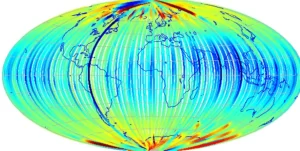ESA’s SMOS and Swarm observe strongest geomagnetic storm since 2017
The European Space Agency’s SMOS and Swarm satellites have, for the first time, successfully tracked a severe solar storm, following an X1.1 solar flare and a halo coronal mass ejection (CME) on March 23, 2024. The CME impacted Earth on March 24, producing a G4 – Severe geomagnetic storm — the strongest geomagnetic storm since September 2017.

